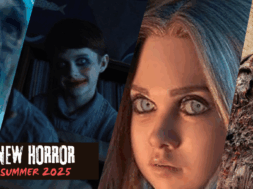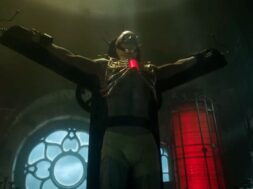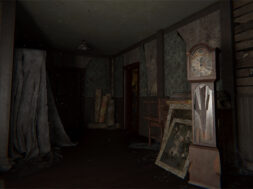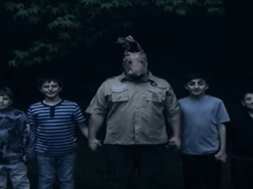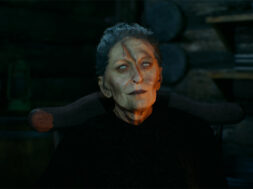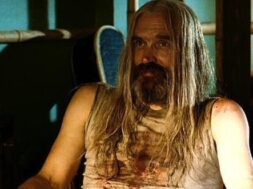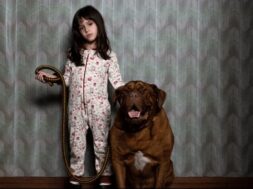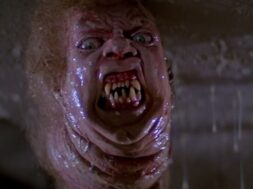Though it hasn’t happened too often in the past 25 years of its run, it’s always a pleasant surprise to see a highly anticipated horror flick kicking off the Film Track of the SXSW Conference. As the last film to do so was the rollicking The Cabin in the Woods five years ago, it would stand to say that John Krasinski‘s A Quiet Place had some high-energy shoes to fill this year. Luckily for festival-goers, Krasinski’s film is a thoroughly entertaining and surprisingly heartfelt thrill ride worthy of its highly publicized opening night slot.
A Quiet Place tells the story of a family living in a post-apocalyptic United States where menacing creatures drawn to sound have all but wiped out the population. The unnamed patriarch of the family (Krasinksi, flexing his dramatic chops) does all he can to keep his wife (his real-life spouse, Emily Blunt) and three children (Millicent Simmonds, Noah Jupe, and Cade Woodward) safe from the monstrosities stalking the nearby woods. Yet despite laying paths of sand along regularly traveled trails to keep footsteps quiet and regularly monitoring a massive surveillance system in their heavily guarded basement, it becomes clear that he cannot keep the creatures away for good and the family is forced into what may very well be the final fight for their lives.
Though its early promotional material called to mind the structure and themes of last year’s subdued It Comes at Night–a family struggling for survival in the midst of an unexplained apocalypse–A Quiet Place is certainly far more upfront from the get-go in its more traditional approach to creature-laden horror. And, boy, do we really get to see these creatures in action. The script, penned by Bryan Woods, Scott Beck, and Krasinski, wastes no time introducing its merciless villains, who immediately send the family into a tailspin in a pre-credits sequence that is quite effective in setting the tone of the film. While there are quite a few jumpscares and moments in the script that challenge believability (even in the scope of a post-apocalyptic horror landscape), audiences are likely to be forgiving, as the film’s more carefully constructed sequences of resonant suspense successfully counterbalance its bevy of short-lived scares.
Genre fans will be pleased to know that as a director, Krasinski succeeds in elevating a relatively familiar horror yarn in way that is emotionally authentic and spirited. Though clearly drawing inspiration from various cinematic classics (Spielberg came to mind more than once during some of the more pulse-pounding sequences), Krasinski’s approach never feels hackneyed. Instead, he connects to his subject matter and fully realized characters here in a deeply genuine way, framing the family’s struggle with refreshing emotional acuity.

This undeniable connection with his material carries over to both Krasinski’s performance and those he pulls from his cast. Both he and Blunt delivered impassioned turns here, and their real-life relationship no doubt contributes to the authenticity of the fear and anguish elicited on screen, especially when the couple’s children are thrust deeper into danger. Elsewhere, Jupe (Wonder, Suburbicon) is a natural in the role of the reluctant middle child being trained by Krasinski to be the next man of the house, and Simmonds (Wonderstruck), who is deaf in real life, delivers an outstandingly nuanced performance as the couple’s deaf daughter struggling with both heightened emotional and physical vulnerability. The performances and chemistry between A Quiet Place‘s young stars are notable highlights here, and the scenes in which they face off with the creatures (that silo scene!) are some of the film’s best.
A Quiet Place‘s technical merits are sure to impress a wide range of filmgoers–even those who don’t particularly gravitate towards horror. The creatures’ sinister design, courtesy of the perennial talent at ILM, is quite impressive, though practical effects fans will likely be disappointed by the reliance on CGI, notably during close-up shots that tend to linger a bit too long to maintain effectiveness. Still, the scenes in which the family comes face-to-face with the monstrosities serve to steer A Quiet Place to wildly fun territory amidst its otherwise heavier moments of straightforward suspense. As a whole, the film’s tone is bolstered by its stunning sound design that masterfully utilizes silence, jarring crashes, and Marco Beltrami‘s tension-building score. The prominent use of American Sign Language throughout is also an ingenious and very well-utilized device in a film like this where the first true spoken line of dialogue doesn’t occur until about half-way through its runtime.
Though it doesn’t entirely break new ground for the genre, A Quiet Place is ultimately a well-made and highly accessible thrill ride of a horror film. Krasinski very clearly knows the story he wants to tell and does so with great skill, backed by a stellar cast and technical team. While audiences may be drawn in by the promise of monster-filled mayhem–which A Quiet Place no doubt delivers–many are sure to be pleasantly surprised by the genuine emotional beats the film hits amidst the scares. Ultimately, A Quiet Place succeeds because it transcends its core premise of a family struggling to simply survive, emerging instead as an equally engaging story of a family working every day to salvage meaning and hope in one another in a world where such concepts are all but lost.

